grisaille murals and ornamentation
Grisaille murals and ornamentation have long been used by the decorative artist and muralist alike to decorate and enhance interior ceilings and walls.
architectural and grisaille murals: images
grisaille murals
Grisaille is an artistic method employing shades of grey to render figurative work.
There is a long tradition of the grisaille technique being used for architectural wall murals, ceilings and figurative embellishments. These are often representative of carved marble or modelled plasterwork. By using perhaps just one hue and variations of tint and tone these figurative renderings can accommodate great complexity and yet remain restrained and receding in quality. This is a strong feature of the beauty and attraction of the radically restricted palette.
history
The style has its origins in the fresco work in Pompeii though it had to wait until the Renaissance for the discovery of linear perspective to provide a more thoroughly accurate method of construction based on the science of how we perceive space.
Many frescos at the Vatican have significant monochrome elements and Mantegna's grisaille mural works of the early sixteenth century show this technique off to grand effect. The idiom has continued from the Renaissance to the present day.
architectural ornamentation
There are broadly two divisions; that of architectural mural trompe l'oeil or quadratura which is in general effect grisaille ornamentation, and straightforward ornamentation per se. Quadratura or grisaille ornamentation is the representation of three dimensional relief architectural elements ( for a sample image of architectural mural ornament click this), usually monochromatic and often found supporting figurative wall murals and ceilings.
Straightforward mural ornamentation (click this for sample image) on the other hand frequently uses the full palette of colours and there is often little attempt to suggest three dimensions.
Polychromatic ornament moves with the times, whether it is the Raphael designed murals of grotesques in the Loggetta of the Sixteenth century or the Neo-classical designs of Robert Adam's Etruscan Room at Osterly.
Having such a long pedigree of use, ornamentation, whether stencilled or hand painted, monochrome or polychrome plays a significant role in the restoration of historic interiors and in designs for period and on occasion modern interiors.


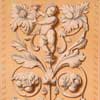 Grisaille wall mural plaster ornament
Grisaille wall mural plaster ornament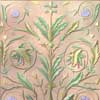 Polychrome wall mural ornament
Polychrome wall mural ornament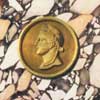 Mural panel of faux bronze and marble
Mural panel of faux bronze and marble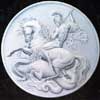 Grisaille mural marble panel in relief
Grisaille mural marble panel in relief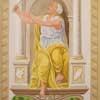 architectural mural panel on canvas
architectural mural panel on canvas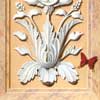 Trompe l'oeil grisaille mural panel
Trompe l'oeil grisaille mural panel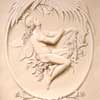 Monochrome trompe l'oeil mural panel
Monochrome trompe l'oeil mural panel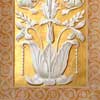 Mural on canvas on gold leaf
Mural on canvas on gold leaf 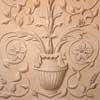 Monochrome grisaille mural carved stone
Monochrome grisaille mural carved stone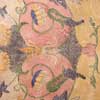 Faux fresco wall mural ornament
Faux fresco wall mural ornament